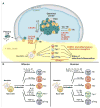T follicular helper cell differentiation, function, and roles in disease
- PMID: 25367570
- PMCID: PMC4223692
- DOI: 10.1016/j.immuni.2014.10.004
T follicular helper cell differentiation, function, and roles in disease
Abstract
Follicular helper T (Tfh) cells are specialized providers of T cell help to B cells, and are essential for germinal center formation, affinity maturation, and the development of most high-affinity antibodies and memory B cells. Tfh cell differentiation is a multistage, multifactorial process involving B cell lymphoma 6 (Bcl6) and other transcription factors. This article reviews understanding of Tfh cell biology, including their differentiation, migration, transcriptional regulation, and B cell help functions. Tfh cells are critical components of many protective immune responses against pathogens. As such, there is strong interest in harnessing Tfh cells to improve vaccination strategies. Tfh cells also have roles in a range of other diseases, particularly autoimmune diseases. Overall, there have been dramatic advances in this young field, but there is much to be learned about Tfh cell biology in the interest of applying that knowledge to biomedical needs.
Figures




References
-
- Avery DT, Bryant VL, Ma CS, de Waal Malefyt R, Tangye SG. IL-21-induced isotype switching to IgG and IgA by human naive B cells is differentially regulated by IL-4. J Immunol. 2008;181:1767–1779. - PubMed
Publication types
MeSH terms
Substances
Grants and funding
LinkOut - more resources
Full Text Sources
Other Literature Sources
Research Materials

